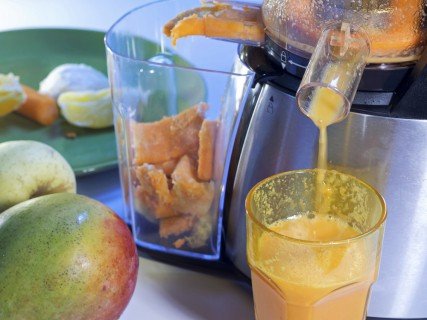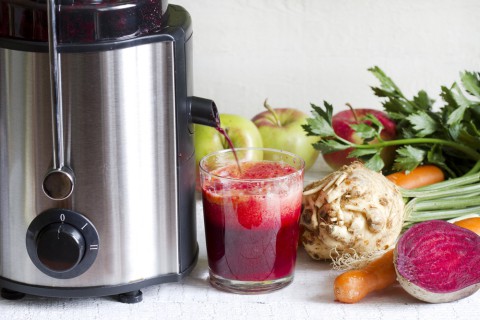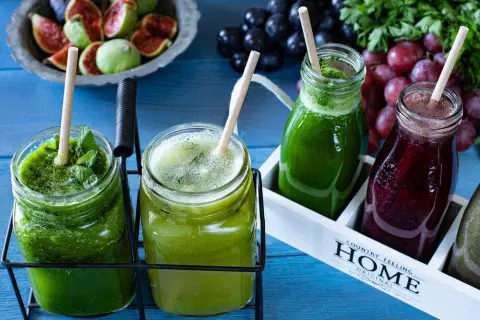Do juicers remove fiber from fruits and vegetables? Yes, most fiber does get removed unless your juicer comes with more than one strainer and the ability to choose to allow some fiber to go through. So yes, there are lots of benefits to juicing, but you may want to consider how you do it if you want to avoid the issues that come with it.
Fiber, also termed as roughage, is the undigested but edible part of a plant that passes almost unchanged through our stomach and intestines. It is a carbohydrate and is an essential element in your diet, as it eases bowel movements, assists in weight loss, and lowers the risk of heart diseases and diabetes. It also flushes out cholesterol and harmful carcinogens from the body.
In this article, we’ll discuss how juicing helps, the role of fiber in your diet, the positives and negatives associated with juicing, and much more.
Table of Contents
- 1 What is Juicing?
- 2 How Does Juicing Help?
- 3 What are the Two Types of Dietary Fiber?
- 4 Does Juicing Remove Fiber?
- 5 How Does Juicing Remove Fiber?
- 6 Does Juicing Fruits and Vegetables Lose Nutrients?
- 7 What are the Benefits of Juicing and Compare Juicing Versus Eating Raw Vegetables
- 8 Is it Better to Juice or Blend Vegetables?
- 9 How to Get Fiber While Juicing
- 10 How to Get Protein While Juicing
- 11 What Vegetables Have Protein for Juicing?
- 12 Are Juicers Worth it?
What is Juicing?
Juicing processes fresh fruits and vegetables to extract all or most of the liquid from them for consumption. All the solid matter like seeds, pulp, and pith get stripped away.
The liquid that’s left contains most of the naturally present nutrients – vitamins, minerals, and antioxidants. The nutrients are present in a highly concentrated form too, as you need a lot of fresh produce to make one glass of juice. However, some fruits and vegetables contain more juice than others.
How Does Juicing Help?
For those who find it hard to have a healthy diet on a regular basis, either because they don’t like eating fruits and vegetables, or because they simply have no time to cook or prioritize eating them, fresh juice is a great way to supplement meals in order to get a good amount of nutrients.
While this is not scientifically proven, many people believe that eliminating all solid food for a few days and only getting their nutrients through juicing helps the body cleanse and detoxify.
What are the Two Types of Dietary Fiber?
Fiber from fruits and vegetables is edible. There are two types of dietary fiber that you should include in your daily diet:
Soluble Fiber
Soluble fiber forms a material similar to gel when dissolved in water. It most importantly helps in lowering LDL (bad cholesterol) and glucose levels in the body. It is recommended for people trying to lose weight, as it fills you up and accounts for very few calories. Some readily available and good soluble fiber sources include apples, oats, peas, guavas, flax seeds, and carrots, among others.
Insoluble Fiber
Insoluble fiber increases stool bulk and helps in the movement of material through your digestive system. If you suffer from irregular stools or constipation, it is a must-have in your diet. It also reduces the risk of hemorrhoids. Some readily available and good insoluble fiber sources include nuts, potatoes, beans, cauliflower, rice bran, wheat bran, and wholegrain foods.
Does Juicing Remove Fiber?
Yes, juicing removes fiber but not all of it. Though juicing is an excellent method to supplement your nutrients, you still need fiber to have a balanced diet. On a daily basis, you need around 28 grams of fiber on a 2000 calorie diet as per the FDA. This is the reason why the medical community does not recommend juices over eating raw fruits and vegetables.
You won’t consume the same amount of fiber when compared to eating fruits and vegetables raw, but be assured that not all of the fiber has to be lost during juicing. There are juicers that remove all pulp and there are juicers that allow you to keep some of the pulp which you can add back to your diet later to boost its fiber content. This provides for an adequate amount of fiber, helping in better absorption of nutrients.
How Does Juicing Remove Fiber?
Once the produce is crushed or torn by the juicer’s teeth or augur, the mass is pushed through a strainer so that only the extracted juice goes through and into your glass or jug. The pulp that remains is most of the fiber and is expelled through another chute where you can collect it to later throw away or to add back into your diet.
Does Juicing Fruits and Vegetables Lose Nutrients?
Most people often believe that juicing fruits and vegetables reduces the nutritional information, but it actually depends on the type of juicer that you are using. There are three types of juicers that you can consider:
These have sharp teeth for shredding thick fruits and vegetables into pulp while the machine simultaneously spins to separate the juice and the pulp. They are fast, affordable, and easy to clean. The main problem with centrifugal juicers is that the juice loses a lot of its nutrients due to the heat generated at the high spinning speed and there is further decay the longer you wait to consume the juice.
Masticating juicers are also referred to as slow juicers or auger juicers. They separate the pulp and the juice by the method of crushing the produce at a slow speed. They have a high yield rate and are multifunctional. Masticating juicers retain most of the nutrients since there is very little heat produced to destroy the juice’s enzymes and antioxidants. The juice can also be consumed over the course of 2-3 days.
These are the best type of juicers available in the market. They have two stages involved and are thus referred to as two-stage juicers. In the first stage, the produce is only chopped into small pieces, then it is put through high pressure in the next stage. It is the second stage where the juice extraction takes place. They are able to yield the most nutrients possible, and they provide for the longest shelf life of around 3 to 5 days. The only downside of these juicers is that they are costly and require a lot of maintenance, so they’re mostly used in juice bars and commercial establishments.
If you prefer to include the fiber from the produce in your drink, then a vacuum blender is better than even a slow juicer because the total lack of air in the jar during and after blending prevents oxidation.
What are the Benefits of Juicing and Compare Juicing Versus Eating Raw Vegetables

Juicing is not healthier than eating raw fruits or vegetables. Juicing extracts the liquid from these raw vegetables and fruits, which contains most of the nutrients, but the healthy dietary fiber is mostly lost during this process. However, there are some benefits to juicing as well. Listing below the pros and cons of juicing and eating raw vegetables:
Juicing
Pros:
Cons:
Eating Raw Vegetables
Pros:
Cons:
Is it Better to Juice or Blend Vegetables?
When the edible parts of fruits and vegetables are blended, it produces a drink with phytonutrients and fiber. The fiber is not extracted out while blending, which is good for the digestive system and aids in weight loss.
Beyond fiber, the fibrous membranes of fruits also contain phytochemicals that are known to be beneficial in maintaining health as well as having anti-cancer properties. The results of a 2012 study found that blending grapefruit versus juicing it, retained significantly more of these phytochemicals.
While blended smoothies can also raise blood sugar, the rise is slower and less dramatic than with juicing.
Juice with little or no fiber is easier to digest than smoothies that retain most of the fiber.
Therefore, when keeping the above points in mind, blending is the healthier option to consider when compared to juicing.
How to Get Fiber While Juicing
 In order to get fiber in your diet while juicing:
In order to get fiber in your diet while juicing:
How to Get Protein While Juicing
If you’re on a juice fast and not getting your protein from meat, lentils, or soy, fear not. Many leafy and dark green vegetables and a few fruits do contain a small amount of protein. Although not comparable to those sources, remember that you will use large quantities of vegetables in order to get several glasses of juices, so those grams do add up.
What Vegetables Have Protein for Juicing?
A variety of vegetables have protein for juicing. An excellent example of it is broccoli. One cup of broccoli gives roughly 4-5 grams of protein. Spinach is another vegetable that contains protein. It has about 5-6 grams of protein per cup. Kale, watercress, collard greens, and turnip greens are some other vegetables that contain a relatively decent amount of protein and can be used for juicing. Some fruits that also contain protein are peaches, strawberries, bananas, papaya, cherries, and kiwi.
Are Juicers Worth it?
Juicers are definitely worth it. Juicers provide the easiest way to add fruits and vegetables to your diet and reduce nutrient loss due to your body’s acidic environment. Juices are tastier and easy to consume as well. You can not deny that certain drawbacks surround juicing, but they can be quickly resolved by just adding the extracted fiber back into your diet.
Using the right type of juicer helps in eliminating the negatives of juicing as well. While the Centrifugal juicer removes quite a bit of the vital nutrients and cold press juicers are costly, it is the masticating juicer that is the right type for the home, as it will give you a high yield rate and most importantly, retain most of the nutrients as there is no heat produced. Juices extracted from masticating juicers also have a good shelf life of about 2 to 3 days.
Also, if you get a juicer that’s easy to clean, then you’ll be happy to juice regularly.

